Development of neutron survey meter using prescila neutron probe
This paper presents the design and validation of a neutron survey meter. The meter consists
of a PRESCILA neutron probe (with good sensitivity, directional response, gamma rejection, and
enhanced high-energy response to 20 MeV) and an electrometer developed at Non-Destructive
Evaluation center. The homogeneity response of the PRESCILA neutron probe was investigated as a
function of distances from the source in order to obtain the appropriate distance for
accurate count-rate measurements using the neutron survey meter. A system consists of the
PRESCILA neutron probe and the Ludlum Model 2326 electrometer was then used for measuring
neutron ambient dose equivalent rates in the range from 50 cm to 200 cm with the step of 25 cm. The
relationship between the count-rates and neutron dose equivalent rates (in the distance ranged from 50
to 200 cm) were deduced to validate the proper operation of the neutron survey meter.
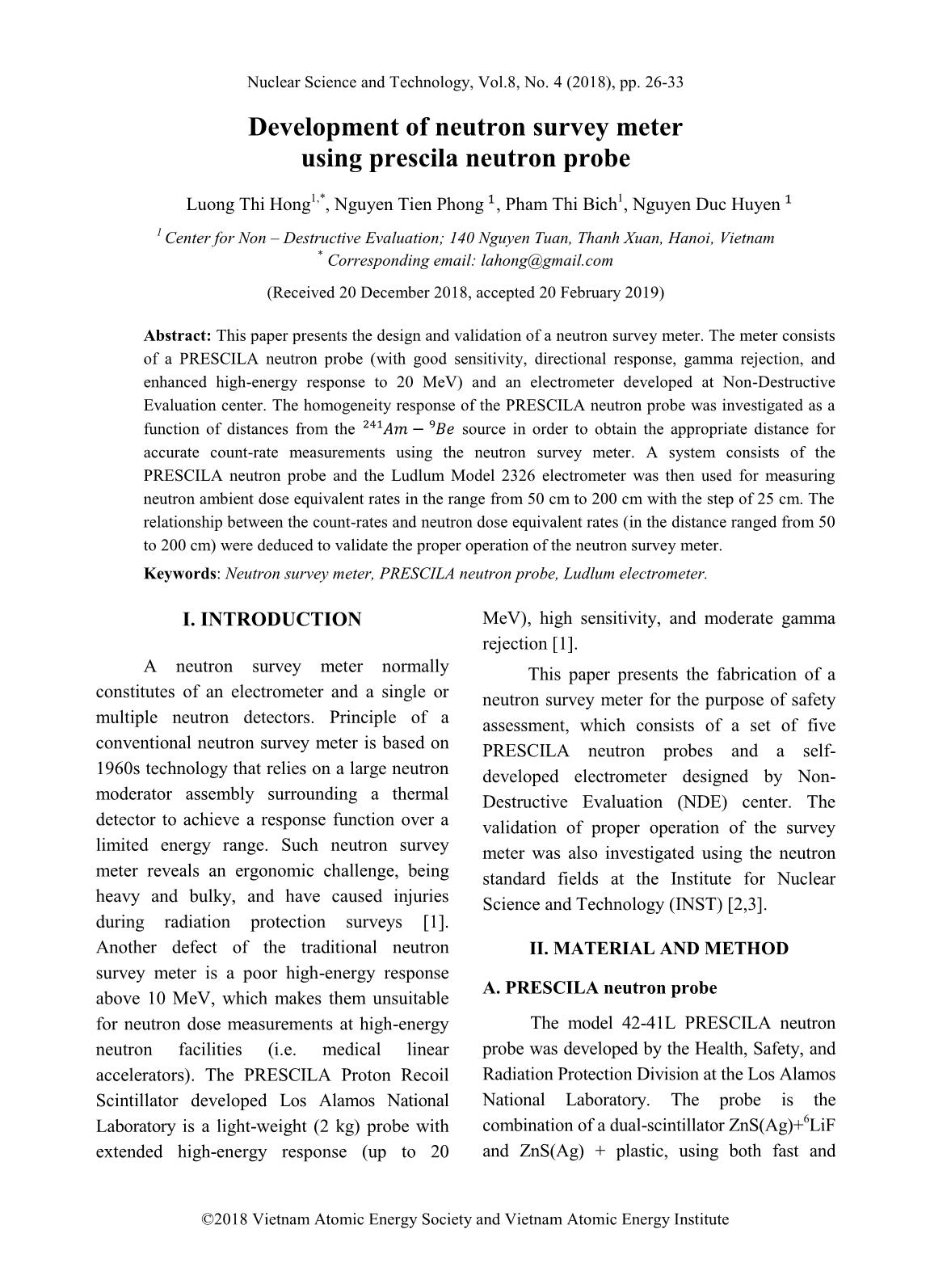
Trang 1
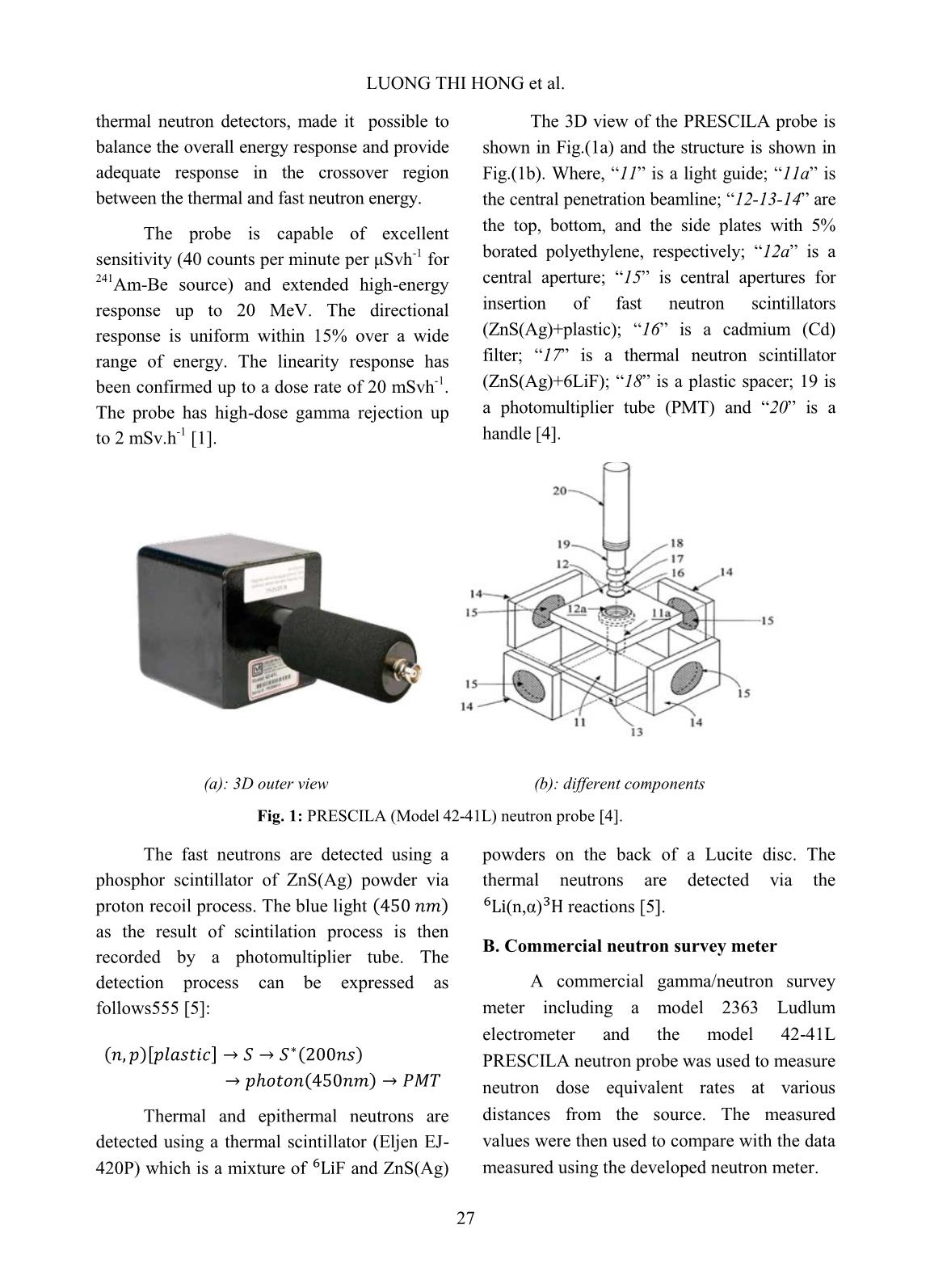
Trang 2
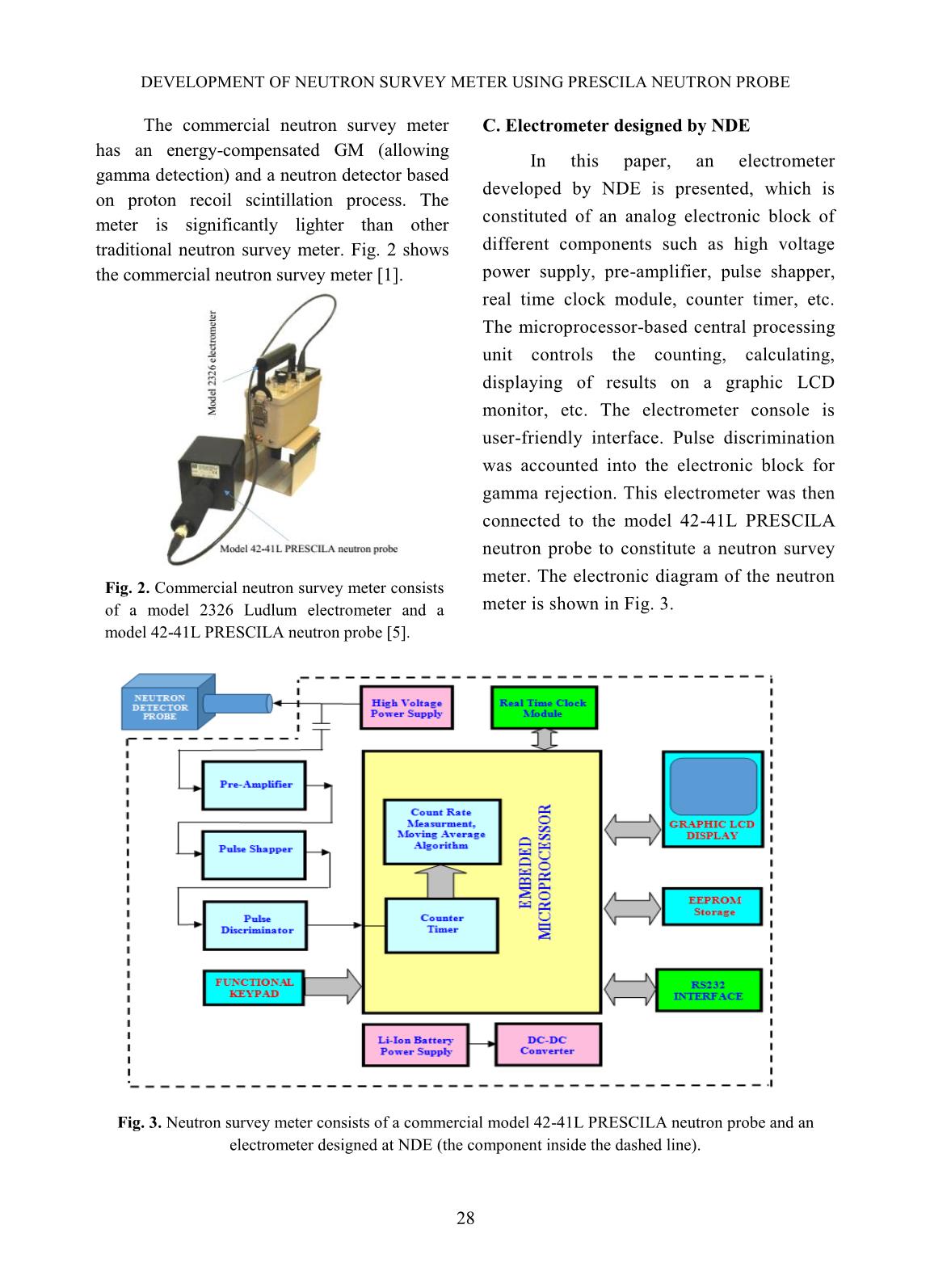
Trang 3
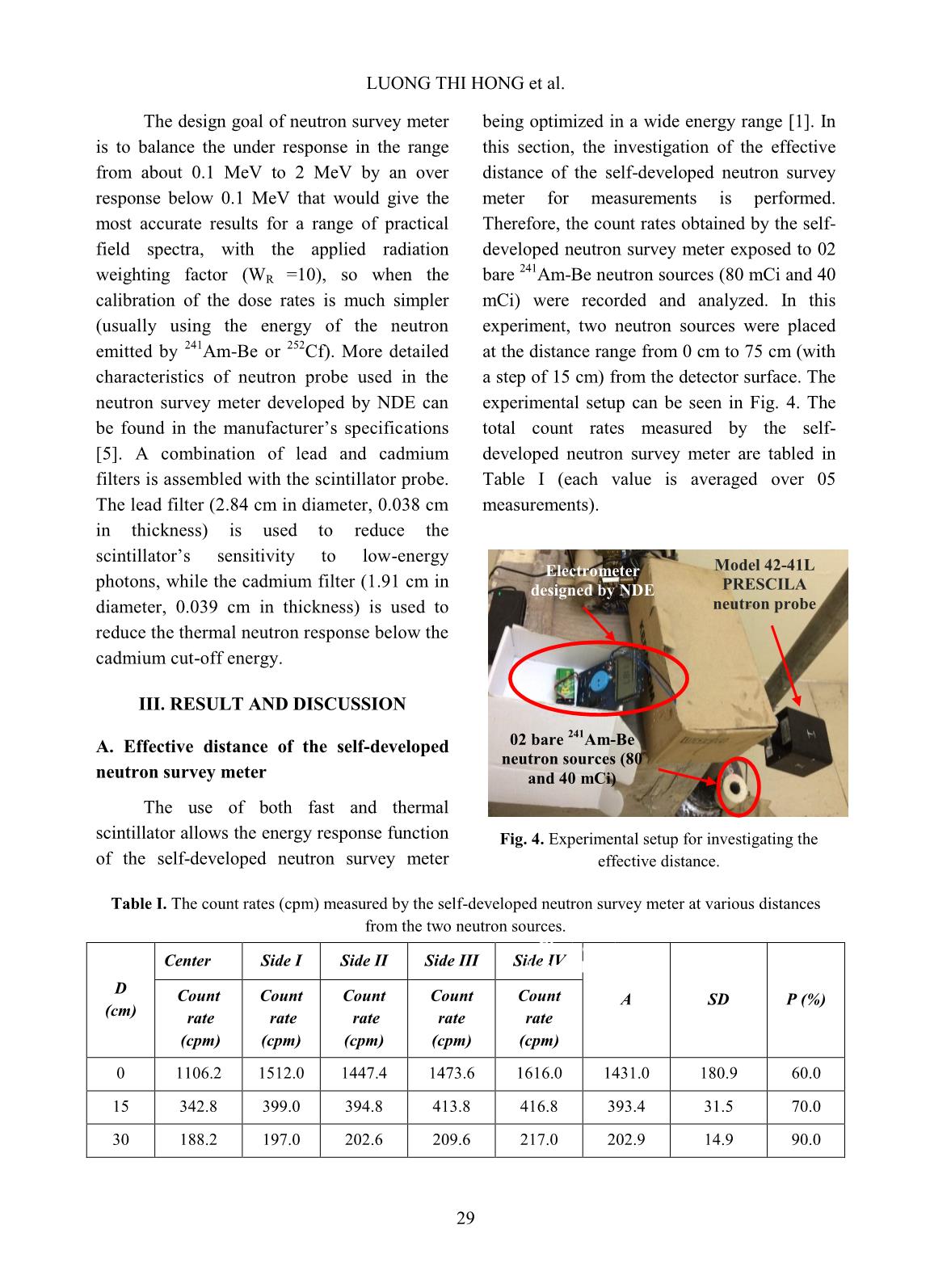
Trang 4
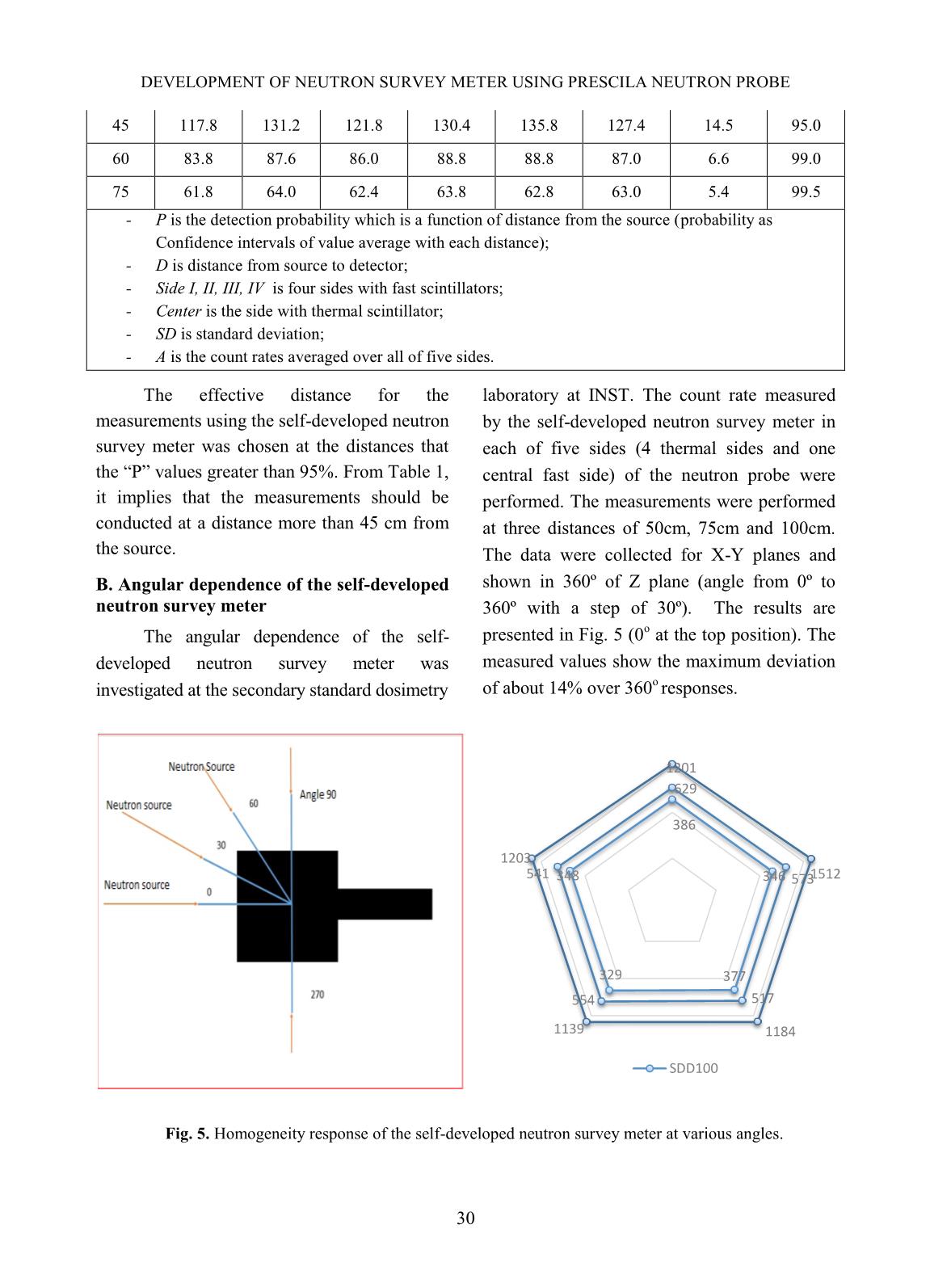
Trang 5
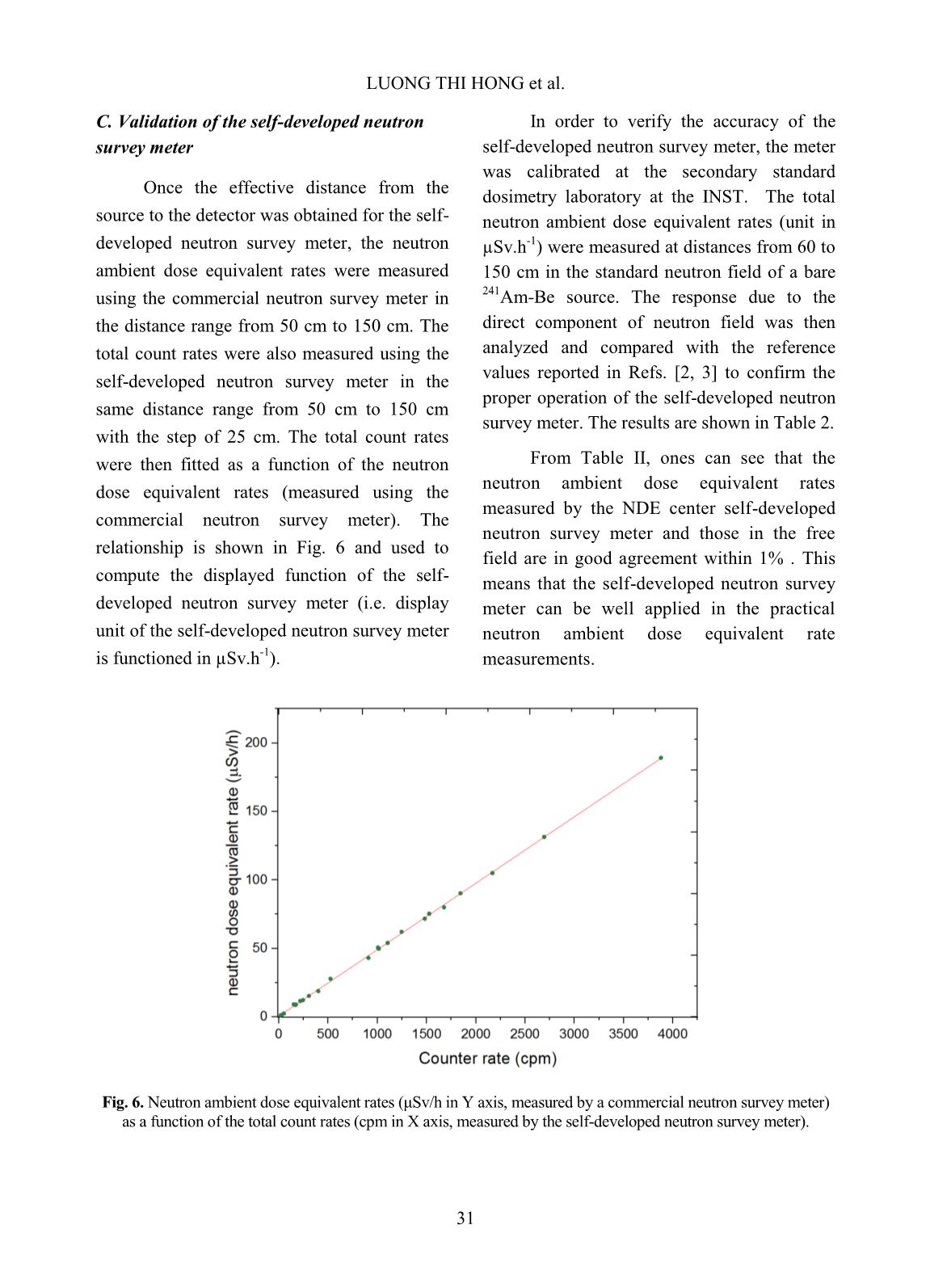
Trang 6
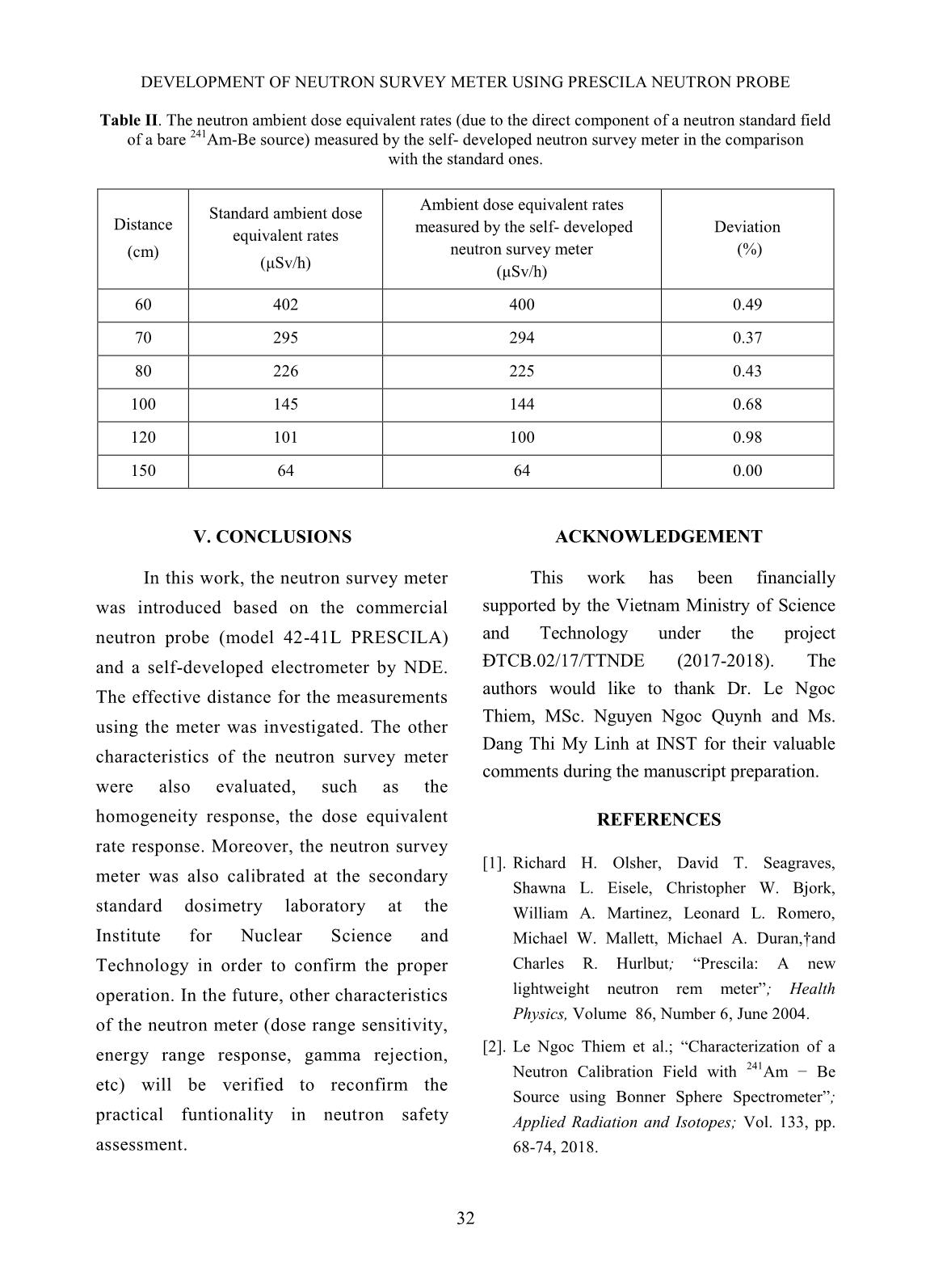
Trang 7
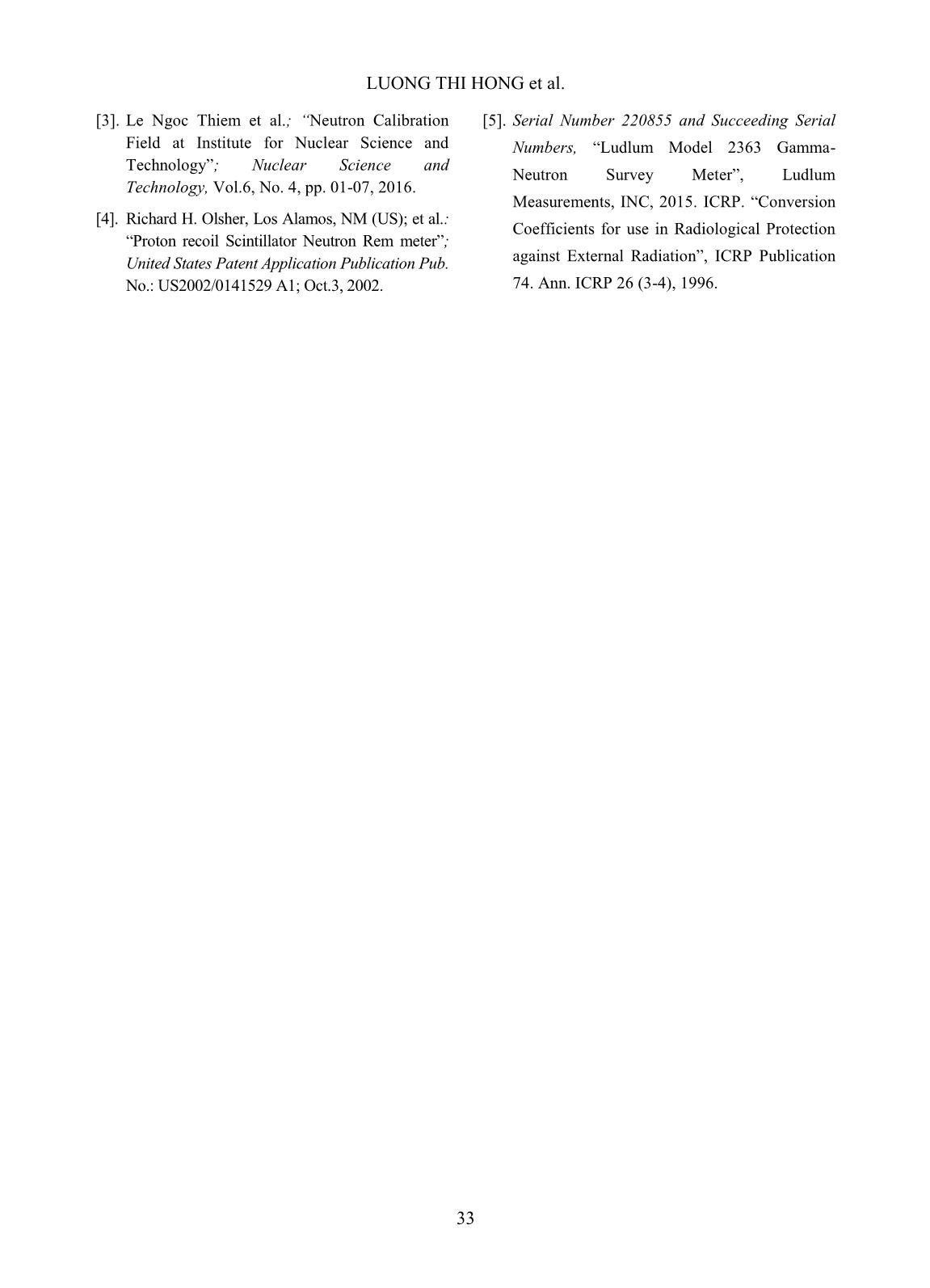
Trang 8
Tóm tắt nội dung tài liệu: Development of neutron survey meter using prescila neutron probe
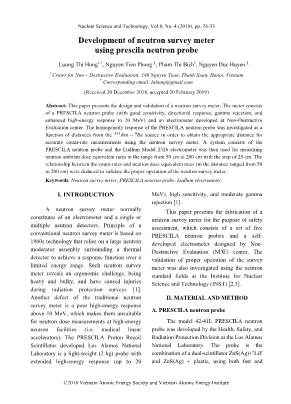
er normally constitutes of an electrometer and a single or multiple neutron detectors. Principle of a conventional neutron survey meter is based on 1960s technology that relies on a large neutron moderator assembly surrounding a thermal detector to achieve a response function over a limited energy range. Such neutron survey meter reveals an ergonomic challenge, being heavy and bulky, and have caused injuries during radiation protection surveys [1]. Another defect of the traditional neutron survey meter is a poor high-energy response above 10 MeV, which makes them unsuitable for neutron dose measurements at high-energy neutron facilities (i.e. medical linear accelerators). The PRESCILA Proton Recoil Scintillator developed Los Alamos National Laboratory is a light-weight (2 kg) probe with extended high-energy response (up to 20 MeV), high sensitivity, and moderate gamma rejection [1]. This paper presents the fabrication of a neutron survey meter for the purpose of safety assessment, which consists of a set of five PRESCILA neutron probes and a self- developed electrometer designed by Non- Destructive Evaluation (NDE) center. The validation of proper operation of the survey meter was also investigated using the neutron standard fields at the Institute for Nuclear Science and Technology (INST) [2,3]. II. MATERIAL AND METHOD A. PRESCILA neutron probe The model 42-41L PRESCILA neutron probe was developed by the Health, Safety, and Radiation Protection Division at the Los Alamos National Laboratory. The probe is the combination of a dual-scintillator ZnS(Ag)+ 6 LiF and ZnS(Ag) + plastic, using both fast and LUONG THI HONG et al. 27 thermal neutron detectors, made it possible to balance the overall energy response and provide adequate response in the crossover region between the thermal and fast neutron energy. The probe is capable of excellent sensitivity (40 counts per minute per μSvh-1 for 241 Am-Be source) and extended high-energy response up to 20 MeV. The directional response is uniform within 15% over a wide range of energy. The linearity response has been confirmed up to a dose rate of 20 mSvh -1 . The probe has high-dose gamma rejection up to 2 mSv.h -1 [1]. The 3D view of the PRESCILA probe is shown in Fig.(1a) and the structure is shown in Fig.(1b). Where, “11” is a light guide; “11a” is the central penetration beamline; “12-13-14” are the top, bottom, and the side plates with 5% borated polyethylene, respectively; “12a” is a central aperture; “15” is central apertures for insertion of fast neutron scintillators (ZnS(Ag)+plastic); “16” is a cadmium (Cd) filter; “17” is a thermal neutron scintillator (ZnS(Ag)+6LiF); “18” is a plastic spacer; 19 is a photomultiplier tube (PMT) and “20” is a handle [4]. (a): 3D outer view (b): different components Fig. 1: PRESCILA (Model 42-41L) neutron probe [4]. The fast neutrons are detected using a phosphor scintillator of ZnS(Ag) powder via proton recoil process. The blue light ( ) as the result of scintilation process is then recorded by a photomultiplier tube. The detection process can be expressed as follows555 [5]: ( )[ ] ( ) ( ) Thermal and epithermal neutrons are detected using a thermal scintillator (Eljen EJ- 420P) which is a mixture of F and ZnS(Ag) powders on the back of a Lucite disc. The thermal neutrons are detected via the (n,α) reactions [5]. B. Commercial neutron survey meter A commercial gamma/neutron survey meter including a model 2363 Ludlum electrometer and the model 42-41L PRESCILA neutron probe was used to measure neutron dose equivalent rates at various distances from the source. The measured values were then used to compare with the data measured using the developed neutron meter. DEVELOPMENT OF NEUTRON SURVEY METER USING PRESCILA NEUTRON PROBE 28 The commercial neutron survey meter has an energy-compensated GM (allowing gamma detection) and a neutron detector based on proton recoil scintillation process. The meter is significantly lighter than other traditional neutron survey meter. Fig. 2 shows the commercial neutron survey meter [1]. Fig. 2. Commercial neutron survey meter consists of a model 2326 Ludlum electrometer and a model 42-41L PRESCILA neutron probe [5]. C. Electrometer designed by NDE In this paper, an electrometer developed by NDE is presented, which is constituted of an analog electronic block of different components such as high voltage power supply, pre-amplifier, pulse shapper, real time clock module, counter timer, etc. The microprocessor-based central processing unit controls the counting, calculating, displaying of results on a graphic LCD monitor, etc. The electrometer console is user-friendly interface. Pulse discrimination was accounted into the electronic block for gamma rejection. This electrometer was then connected to the model 42-41L PRESCILA neutron probe to constitute a neutron survey meter. The electronic diagram of the neutron meter is shown in Fig. 3. Fig. 3. Neutron survey meter consists of a commercial model 42-41L PRESCILA neutron probe and an electrometer designed at NDE (the component inside the dashed line). LUONG THI HONG et al. 29 The design goal of neutron survey meter is to balance the under response in the range from about 0.1 MeV to 2 MeV by an over response below 0.1 MeV that would give the most accurate results for a range of practical field spectra, with the applied radiation weighting factor (WR =10), so when the calibration of the dose rates is much simpler (usually using the energy of the neutron emitted by 241 Am-Be or 252 Cf). More detailed characteristics of neutron probe used in the neutron survey meter developed by NDE can be found in the manufacturer’s specifications [5]. A combination of lead and cadmium filters is assembled with the scintillator probe. The lead filter (2.84 cm in diameter, 0.038 cm in thickness) is used to reduce the scintillator’s sensitivity to low-energy photons, while the cadmium filter (1.91 cm in diameter, 0.039 cm in thickness) is used to reduce the thermal neutron response below the cadmium cut-off energy. III. RESULT AND DISCUSSION A. Effective distance of the self-developed neutron survey meter The use of both fast and thermal scintillator allows the energy response function of the self-developed neutron survey meter being optimized in a wide energy range [1]. In this section, the investigation of the effective distance of the self-developed neutron survey meter for measurements is performed. Therefore, the count rates obtained by the self- developed neutron survey meter exposed to 02 bare 241 Am-Be neutron sources (80 mCi and 40 mCi) were recorded and analyzed. In this experiment, two neutron sources were placed at the distance range from 0 cm to 75 cm (with a step of 15 cm) from the detector surface. The experimental setup can be seen in Fig. 4. The total count rates measured by the self- developed neutron survey meter are tabled in Table I (each value is averaged over 05 measurements). Fig. 4. Experimental setup for investigating the effective distance. Table I. The count rates (cpm) measured by the self-developed neutron survey meter at various distances from the two neutron sources. D (cm) Center Side I Side II Side III Side IV A SD P (%) Count rate (cpm) Count rate (cpm) Count rate (cpm) Count rate (cpm) Count rate (cpm) 0 1106.2 1512.0 1447.4 1473.6 1616.0 1431.0 180.9 60.0 15 342.8 399.0 394.8 413.8 416.8 393.4 31.5 70.0 30 188.2 197.0 202.6 209.6 217.0 202.9 14.9 90.0 Electrometer designed by NDE Model 42-41L PRESCILA neutron probe 02 bare 241 Am-Be neutron sources (80 and 40 mCi) Electrometer designed by NDE DEVELOPMENT OF NEUTRON SURVEY METER USING PRESCILA NEUTRON PROBE 30 The effective distance for the measurements using the self-developed neutron survey meter was chosen at the distances that the “P” values greater than 95%. From Table 1, it implies that the measurements should be conducted at a distance more than 45 cm from the source. B. Angular dependence of the self-developed neutron survey meter The angular dependence of the self- developed neutron survey meter was investigated at the secondary standard dosimetry laboratory at INST. The count rate measured by the self-developed neutron survey meter in each of five sides (4 thermal sides and one central fast side) of the neutron probe were performed. The measurements were performed at three distances of 50cm, 75cm and 100cm. The data were collected for X-Y planes and shown in 360º of Z plane (angle from 0º to 360º with a step of 30º). The results are presented in Fig. 5 (0 o at the top position). The measured values show the maximum deviation of about 14% over 360 o responses. Fig. 5. Homogeneity response of the self-developed neutron survey meter at various angles. 386 346 377 329 348 629 573 517 554 541 1201 1512 1184 1139 1203 SDD100 45 117.8 131.2 121.8 130.4 135.8 127.4 14.5 95.0 60 83.8 87.6 86.0 88.8 88.8 87.0 6.6 99.0 75 61.8 64.0 62.4 63.8 62.8 63.0 5.4 99.5 - P is the detection probability which is a function of distance from the source (probability as Confidence intervals of value average with each distance); - D is distance from source to detector; - Side I, II, III, IV is four sides with fast scintillators; - Center is the side with thermal scintillator; - SD is standard deviation; - A is the count rates averaged over all of five sides. LUONG THI HONG et al. 31 C. Validation of the self-developed neutron survey meter Once the effective distance from the source to the detector was obtained for the self- developed neutron survey meter, the neutron ambient dose equivalent rates were measured using the commercial neutron survey meter in the distance range from 50 cm to 150 cm. The total count rates were also measured using the self-developed neutron survey meter in the same distance range from 50 cm to 150 cm with the step of 25 cm. The total count rates were then fitted as a function of the neutron dose equivalent rates (measured using the commercial neutron survey meter). The relationship is shown in Fig. 6 and used to compute the displayed function of the self- developed neutron survey meter (i.e. display unit of the self-developed neutron survey meter is functioned in µSv.h -1 ). In order to verify the accuracy of the self-developed neutron survey meter, the meter was calibrated at the secondary standard dosimetry laboratory at the INST. The total neutron ambient dose equivalent rates (unit in µSv.h -1 ) were measured at distances from 60 to 150 cm in the standard neutron field of a bare 241 Am-Be source. The response due to the direct component of neutron field was then analyzed and compared with the reference values reported in Refs. [2, 3] to confirm the proper operation of the self-developed neutron survey meter. The results are shown in Table 2. From Table II, ones can see that the neutron ambient dose equivalent rates measured by the NDE center self-developed neutron survey meter and those in the free field are in good agreement within 1% . This means that the self-developed neutron survey meter can be well applied in the practical neutron ambient dose equivalent rate measurements. Fig. 6. Neutron ambient dose equivalent rates (μSv/h in Y axis, measured by a commercial neutron survey meter) as a function of the total count rates (cpm in X axis, measured by the self-developed neutron survey meter). DEVELOPMENT OF NEUTRON SURVEY METER USING PRESCILA NEUTRON PROBE 32 Table II. The neutron ambient dose equivalent rates (due to the direct component of a neutron standard field of a bare 241 Am-Be source) measured by the self- developed neutron survey meter in the comparison with the standard ones. Distance (cm) Standard ambient dose equivalent rates (μSv/h) Ambient dose equivalent rates measured by the self- developed neutron survey meter (μSv/h) Deviation (%) 60 402 400 0.49 70 295 294 0.37 80 226 225 0.43 100 145 144 0.68 120 101 100 0.98 150 64 64 0.00 V. CONCLUSIONS In this work, the neutron survey meter was introduced based on the commercial neutron probe (model 42-41L PRESCILA) and a self-developed electrometer by NDE. The effective distance for the measurements using the meter was investigated. The other characteristics of the neutron survey meter were also evaluated, such as the homogeneity response, the dose equivalent rate response. Moreover, the neutron survey meter was also calibrated at the secondary standard dosimetry laboratory at the Institute for Nuclear Science and Technology in order to confirm the proper operation. In the future, other characteristics of the neutron meter (dose range sensitivity, energy range response, gamma rejection, etc) will be verified to reconfirm the practical funtionality in neutron safety assessment. ACKNOWLEDGEMENT This work has been financially supported by the Vietnam Ministry of Science and Technology under the project ĐTCB.02/17/TTNDE (2017-2018). The authors would like to thank Dr. Le Ngoc Thiem, MSc. Nguyen Ngoc Quynh and Ms. Dang Thi My Linh at INST for their valuable comments during the manuscript preparation. REFERENCES [1]. Richard H. Olsher, David T. Seagraves, Shawna L. Eisele, Christopher W. Bjork, William A. Martinez, Leonard L. Romero, Michael W. Mallett, Michael A. Duran,†and Charles R. Hurlbut; “Prescila: A new lightweight neutron rem meter”; Health Physics, Volume 86, Number 6, June 2004. [2]. Le Ngoc Thiem et al.; “Characterization of a Neutron Calibration Field with 241Am − Be Source using Bonner Sphere Spectrometer”; Applied Radiation and Isotopes; Vol. 133, pp. 68-74, 2018. LUONG THI HONG et al. 33 [3]. Le Ngoc Thiem et al.; “Neutron Calibration Field at Institute for Nuclear Science and Technology”; Nuclear Science and Technology, Vol.6, No. 4, pp. 01-07, 2016. [4]. Richard H. Olsher, Los Alamos, NM (US); et al.: “Proton recoil Scintillator Neutron Rem meter”; United States Patent Application Publication Pub. No.: US2002/0141529 A1; Oct.3, 2002. [5]. Serial Number 220855 and Succeeding Serial Numbers, “Ludlum Model 2363 Gamma- Neutron Survey Meter”, Ludlum Measurements, INC, 2015. ICRP. “Conversion Coefficients for use in Radiological Protection against External Radiation”, ICRP Publication 74. Ann. ICRP 26 (3-4), 1996.
File đính kèm:
 development_of_neutron_survey_meter_using_prescila_neutron_p.pdf
development_of_neutron_survey_meter_using_prescila_neutron_p.pdf

